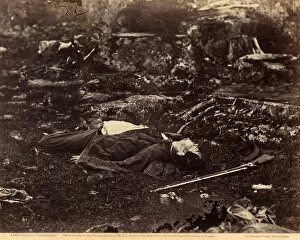Alexander Gardner Collection (#7)
Alexander Gardner was a renowned photographer during the American Civil War
For sale as Licensed Images
Choose your image, Select your licence and Download the media
Alexander Gardner was a renowned photographer during the American Civil War, capturing powerful images that depicted the harsh realities of battle and life on the frontlines. His photographs provide a glimpse into history, showcasing both Confederate and Union soldiers in various settings. Lieutenant Washington, a Confederate Prisoner, and Capt. Custis (for Custer) U. S. A are just two Gardner's subjects. These portraits reveal the stark contrast between captor and captive, highlighting the human toll of war. Gardner's Photographic Gallery at 7th & D Street in Washington, D. C. , served as a hub for his work. It was here that he displayed his captivating images to an eager audience seeking to understand the magnitude of conflict. Quaker Guns in Centreville, Virginia, captured by Barnard & Gibson in March 1862, showcases deceptive tactics employed by Confederate forces to mislead their opponents. These wooden cannons were strategically placed to give the illusion of formidable artillery positions. Manassas Junction also became a subject for Barnard & Gibson's lens during this time period. Their photographs depict scenes of destruction and ruin caused by previous battles fought there. The remnants serve as haunting reminders of lives lost and communities shattered. Fortifications at Manassas further demonstrate the immense efforts made by both sides to fortify their positions during wartime. These structures stand as testaments to ingenuity amidst chaos. The Stone Church in Centreville stands untouched amidst its war-torn surroundings—a symbol of resilience amid devastation—captured beautifully through Barnard & Gibson's lens. Moving forward chronologically, David Knox takes over as creator with Mortar Dictator before Petersburg in October 1864—an image that captures one aspect of technological advancements used during warfare at this stage. In August 1864, Knox presents A Fancy Group—a photograph depicting soldiers posing together with pride despite their challenging circumstances—an embodiment of camaraderie amidst adversity.







